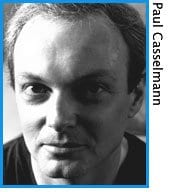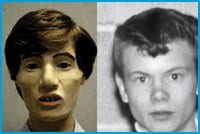With the acquittal of Ivan Mendez-Romero earlier this year the death of Janko Naglic joins the list of unsolved killings involving queer and trans people.
Nursing student and sex worker Cassandra Do was found strangled to death in her Gloucester St apartment on Aug 26, 2003.
Artist and University of Toronto lecturer David Buller was found stabbed to death in his office on Spadina Cres on Jan 19, 2001.
In December 1967 a young man’s naked remains were found in bushes on a country road at Balsam Lake Provincial Park, near Coboconk. He has yet to be identified.
In May 1968 the skeletal remains of a second young man were found by the side of a road near a Schomberg farm. His identity wasn’t known until 2007 when he was discovered to be Richard “Dickie” Hovey, a handsome guitarist from Fredericton, Nova Scotia. He was 17 at the time of his death.
The Ontario Provincial Police and the Toronto police homicide department each have cold-case sections that keep a flicker of investigation going years after leads have dried up.
The Criminal Investigation Bureau (CIB), which handles all provincial murder investigations, does regular reviews of all unsolved murders. Cold cases can be reopened when new information or investigative technology becomes available, as in 2006 when the cases of Hovey and the unidentified youth were reopened to take advantage of DNA technology and new facial reconstruction techniques.
The Toronto police homicide department has a three-person cold-case squad headed by Staff Sgt Reg Pitt. He says staff “field calls from relatives” and, like the CIB, try to apply new technologies to create new leads.
Pitt says Toronto homicide is revamping its website to make it “more interactive and YouTube-able” by adding video reenactments of crimes in the hopes of sparking new leads.
In 2006 the OPP partnered with the province’s Office of the Chief Coroner to create the Missing Persons and Unidentified Bodies/Remains Unit. The unit’s website includes photos of unidentified bodies, the circumstances under which they were found and lists of items found with them. One month after the website’s launch one of the cold cases was solved.
Douglas Janoff, the author of Pink Blood: Homophobic Violence in Canada, says there were 107 queer-related murders between 1990 and 2004, of which more than 20 remain unsolved. He argues that even in cases that have led to convictions some killers got off with “wrist-slapping manslaughter convictions.”
“I honestly don’t think many of the cold cases will be solved because of the randomness of some of these crimes, especially when prostitution is involved,” says Janoff. “Prostitution involves a steady stream of new and different possible perpetrators and/or victims. Police are much more able to put together common patterns of past repeat relationships than with strangers who walk into a person’s life for a quickie.
“As long as prostitution remains in the shadows, and as long as people bring strangers into homes without closed-circuit security cameras, it will not only be high-risk but also the sort of environment that is difficult for the police to track.”
Here’s a closer look at four unsolved homicide cases.
Cassandra Do
Cassandra Do was 32 when she was found strangled to death in her 60 Gloucester St apartment on Aug 26, 2003. The investigation into her killing was recently reactivated.
“We have a new lead that we are checking out,” says Toronto police cold-case squad’s Reg Pitt, adding that he isn’t able to discuss what the new information might be or how it came to police attention.
Do, who was transsexual, had been studying nursing at George Brown College and working out of her apartment as a sex worker under the name of Tula.
“She looked like a model and was very glamorous,” says friend Mark Hart, adding that they regularly hung out together at Sneakers, then a gay bar on Yonge St.
Det Sgt Craig Samson, who led the initial investigation, says at first there were several good leads. There were phone records for her cell phone and the escort agency Do worked for. The man believed to be her killer made a date with her by phone but it turned out that all the calls had been placed from a pay phone.
There was also DNA found on Do’s body believed to be from the killer. Investigators matched it via the National DNA Databank to a man who beat and sexually assaulted a female sex worker on Jarvis St in 1997. The perpetrator in that attack was described as a tall black man, six-foot, three-inches, between 30 to 40 years old, 230 to 350 pounds and with a shaved head.
Samson says there was another suspect but that he was cleared when his DNA didn’t match the evidence. He adds that he initially thought the case would be a simple one to solve because of the DNA evidence.
“It was very frustrating having the DNA evidence which is an excellent clue and to get no real results in the end,” says Samson, adding that because he knows Do had clients from the US he also tried matching the DNA against US databases.
Samson says he spoke to as many of Do’s clients as he could identify — “she kept no records” — as well as investigating all the phone numbers found on her cell phone but that all his leads dried up in late 2003.
Vigils were held for Do, a Vietnamese-Canadian who spoke fluent French, in Allan Gardens and attracted more than 100.
David Buller
Artist and professor David Buller was 50 when he was killed in his office at 1 Spadina Cres on U of T’s downtown campus. Buller was a 15-year veteran faculty member in the Fine Arts department where he was popular with students.
“He was likely at his computer sitting on his chair writing when the killer came in during the school day on Jan 18, 2001,” says Det Sgt Ken Taylor. “He was stabbed repeatedly in the torso and as he fell from his chair his body hit the computer cord and pulled out the plug.”
Saunders says there was no useable DNA evidence found at the scene and no security camera in the building at that time.
It’s believed that Buller was killed between 1pm when he was spotted near the building that housed his office and 6pm when he was supposed to be teaching a class. His body was not discovered until 7am the next morning when he was found by a caretaker.
“The crime scene was pristine,” says Taylor, adding that robbery has been ruled out as a motive.
“The killer knew where he was going and likely knew him,” says Saunders, adding that Buller’s office space was in an out-of-the-way location.
Saunders says police investigated Buller’s relationships, students and academic colleagues as well as his online life on chat sites including M4M4Sex but identified no suspects.
Taylor, a veteran homicide investigator, says he’s haunted by the case. He says he still sometimes “gets up in the middle of the night thinking of it.”
“It really bothers me… that someone just walked in, stabbed the professor to death and didn’t get caught,” says Taylor.
On Jan 27, 2001 more than 400 people filled Hart House’s Great Hall for a memorial to Buller and a memorial scholarship was created in his honour.
“David Buller’s death strikes at the core of this community of students, staff and faculty,” said Carl Amrhein, then dean of the Faculty of Arts and Science at the memorial, “a community built on trust and the free exchange of ideas.”
Saunders says the police worked closely with Buller’s family, friends and colleagues but “exhausted all investigated avenues.”
Toronto police are offering a $50,000 reward for information leading to the arrest and conviction of Buller’s killer.
Anyone with new information about the deaths of David Buller or Cassandra Do is asked to contact Det Sgt Reg Pitt at (416) 808-7397.
Richard Hovey & John Doe
In December 1967 the decomposing remains of a slender, short young man were found at Balsam Lake Provincial Park, near Coboconk. In May 1968 the skeletal remains of a second thin young man were found in the bushes on a Schomberg farm. Both men had been murdered in 1967 and the two cases “are tied by MO [modus operandi], geography and victimology,” says OPP Det Insp Dave Quigley.
In 2006 the investigation into these crimes was reopened and facial reconstructions were made available to the public, including at a special meeting at the 519 Community Centre and online. The reconstructions led to the identification of the man found near Schomberg as Richard “Dickie” Hovey. The identification was confirmed by DNA testing.
Quigley says that the identification is “a real boost” to the investigation, adding that the cases remain active. He says he is still hoping to identify the second victim and that he’s hopeful that the uniqueness of his physical condition — he had an atypical jaw structure which would have caused him to make involuntary clicking sounds — will help to identify him.
Quigley says the new facial reconstruction technology and DNA testing available was a factor in reopening the cases. The upcoming parole hearing of convicted serial killer Jimmy Greenidge — a person of interest in the case — was also a factor.
Greenidge, also known as Jim Henry, has a grim history of sexual assault and murder. In 1955, at the age of 18, he was convicted of raping a 14-year-old girl in Toronto. In 1962 he was convicted of an assault at a movie theatre known for casual gay sex. He was convicted in the 1967 attempted murder of William Howell who had been found near death, naked with his throat slashed and hands bound in a field near Barrie. In 1968 Greenidge was convicted of the manslaughter in the death of Robert Mortimer, whose remains were found in Markham.
“It was a very brutal killing,” said Toronto police homicide officer Jim Crawford when Greenidge was sentenced to 10 years in 1967.
In 1982 Greenidge was convicted of first-degree murder in BC for the 1981 killing of 24-year-old Virginia Fells. At the sentencing BC Supreme Court Justice George Murray called the murder “brutal, callous and appalling.” Greenidge is currently serving the 25th year of a life sentence for Fells’ murder.
In spring 2007 experts at his last parole hearing said that Greenidge, now 70, “is still at risk for violent sex crimes.”
Anyone with new information about the deaths of Richard “Dickie” Hovey or the unidentified youth found in 1968, or anyone who had involvement with James Henry Greenidge in the 1960s is asked to call Det Insp Dave Quigley at (705) 329-6330. The Toronto police cold case website is Torontopolice.on.ca/homicide/coldcases.php. The OPP’s unidentified remains site is Opp.ca/Investigative/UnidentifiedRemains/index.htm.



 Why you can trust Xtra
Why you can trust Xtra


